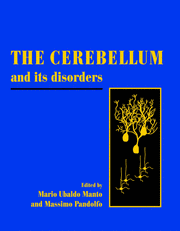Book contents
- Frontmatter
- Contents
- List of contributors
- Preface
- Acknowledgments
- Foreword by Sid Gilman
- PART I INTRODUCTION
- PART II THEORIES OF CEREBELLAR CONTROL
- PART III CLINICAL SIGNS AND PATHOPHYSIOLOGICAL CORRELATIONS
- PART IV SPORADIC DISEASES
- PART V TOXIC AGENTS
- PART VI ADVANCES IN GRAFTS
- PART VII NEUROPATHOLOGY
- PART VIII DOMINANTLY INHERITED PROGRESSIVE ATAXIAS
- PART IX RECESSIVE ATAXIAS
- Index
Preface
Published online by Cambridge University Press: 06 July 2010
- Frontmatter
- Contents
- List of contributors
- Preface
- Acknowledgments
- Foreword by Sid Gilman
- PART I INTRODUCTION
- PART II THEORIES OF CEREBELLAR CONTROL
- PART III CLINICAL SIGNS AND PATHOPHYSIOLOGICAL CORRELATIONS
- PART IV SPORADIC DISEASES
- PART V TOXIC AGENTS
- PART VI ADVANCES IN GRAFTS
- PART VII NEUROPATHOLOGY
- PART VIII DOMINANTLY INHERITED PROGRESSIVE ATAXIAS
- PART IX RECESSIVE ATAXIAS
- Index
Summary
Our knowledge of cerebellar functions has increased exponentially during the last two decades. Powerful new neuroimaging techniques and the spectacular development of molecular biology are probably the most striking examples of developments that have completely changed the field.
We started the project that led to this book because we were convinced that the time was ripe for an updated, comprehensive text attempting to summarize this new knowledge and present it in a coherent, systematic fashion. In preparing this book, our aim was to present the current perspective on the functional roles of the cerebellum as well as on the clinical and pathophysiological aspects of cerebellar diseases. We wanted to provide a comprehensive review of the major advances of these last years.
The Cerebellum and its Disorders is divided into nine parts, each giving an overview of a particular area. In each chapter the latest discoveries are presented in the context of their clinical relevance. In Part I, the fundamental aspects of cerebellar structure and functions are covered. This part serves as the basis for those that follow. Part II addresses the main models of cerebellar function that have been proposed so far. Part III includes an overview of cerebellar symptoms and their pathophysiology, including the emerging concepts on the cognitive roles of the cerebellum and their clinical implications. Part IV addresses the broad spectrum of sporadic cerebellar disorders. Part V deals with the effect of toxic agents on the cerebellum. Part VI covers the growing area of cerebellar grafts. Part VII summarizes the neuropathology of cerebellar disorders. Parts VIII and IX are dedicated to the genetics of dominant and recessive cerebellar ataxias, respectively.
- Type
- Chapter
- Information
- The Cerebellum and its Disorders , pp. xvii - xviiiPublisher: Cambridge University PressPrint publication year: 2001

